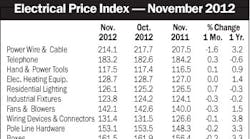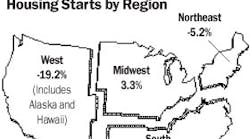Latest from Mag
People - Dec 21, 2012
Obituaries - Dec 21, 2012
November EPI Index Shows No Change
Housing Starts Dip 4% in November
Electrical Marketing - December 21, 2012
Around the Industry - Dec 21, 2012
Total 2001 sales for the 250 largest electrical distributors decreased by 8.4 percent to an estimated $36.9 billion, according to the 2002 Top 250 electrical distributors listing, to be published in the upcoming issue of Electrical Wholesaling.
The decrease seems small, compared to some of the year-to-year sales declines that electrical distributors are experiencing in the first half of 2002.
The number of employees in Top 250 companies decreased to 76,781. Of the 194 distributors that supplied employee counts for both 2000 and 2001, the average percentage decline was 3.8 percent, a reflection of the cost-cutting measures that so many companies have had to employ. Surprisingly, the number of branches that the Top 250 distributors operate jumped by 147 locations to 4,846 branches.
For the second year in a row, the Top 250's market share of total sales through electrical distributors was at the 50-percent mark. This important milestone is a clear indication of the increased pace of consolidation in the electrical wholesaling industry. But it's important to remember that there are probably at least 4,000 other distributors of electrical supplies that account for at least $36.3 billion in sales. (According to EW's 2001 Market Planning Guide, electrical distributors forecasted $73.3 billion in total sales for 2001.)
Consolidation
When one compares the 2002 Top 250 listing with the Top 250 listing compiled in 1992, the pace of consolidation becomes quickly apparent — at least 52 companies from the 1992 listing have been acquired or merged with other companies.
Although consolidation has slowed down in the last year, as you can see in the chart on page 5, it's still reshaping the electrical wholesaling industry. In less than two years, according to reports in Electrical Marketing newsletter, at least 40 companies have been acquired. Many of these companies were 250 Biggest distributors, and most were acquired by the U.S. or North American subsidiaries of Hagemeyer NV, Naarden, Netherlands; Rexel SA, Paris; and Sonepar SA, Paris.
While no market areas are untouched by consolidation, some felt it more than others including Southern California, the Baltimore-Washington, D.C., metro and Minneapolis.
For instance, during the past year, the Southern California market has seen some big acquisitions, led by San Diego-based OneSource Distributor Inc.'s acquisitions of Argo Electric Supply Co., Downey, Calif.; Orange Coast Electric Supply Co. Inc., Irvine, Calif.; and Pacific Parts and Controls Inc., Chino, Calif.
The Minneapolis market has a new look, with the purchase of Viking Electric Supply Inc., St. Paul, Minn., by Sonepar. Additionally, Northland Electric Supply, Minneapolis, has been acquired in a joint venture by Van Meter Industrial, Cedar Rapids, Iowa, and Werner Electric Supply, Neenah, Wis. Interestingly, Werner had planned on acquiring Van Meter as well as Northland last year but left a provision in the letter of intent allowing for poor economic conditions. So, instead Werner and Van Meter are 50 percent owners of Northland.
National chains continue to grow
Another measure of industry consolidation is the market share of the chains. The industry's national chains, Graybar Electric Co. Inc., St. Louis; WESCO International Inc., Pittsburgh; Consolidated Electrical Distributors Inc., Westlake Village, Calif.; and GE Supply Inc., Shelton, Conn., are the four companies with branches in all regions of the United States. In 2001, their combined sales volume was $13.3 billion, and their combined market share was over 18 percent. That's up a point from 2001. If one considers Rexel a national distributor and adds its $2 billion in sales to this figure, the market share of the chains tops 20 percent.

